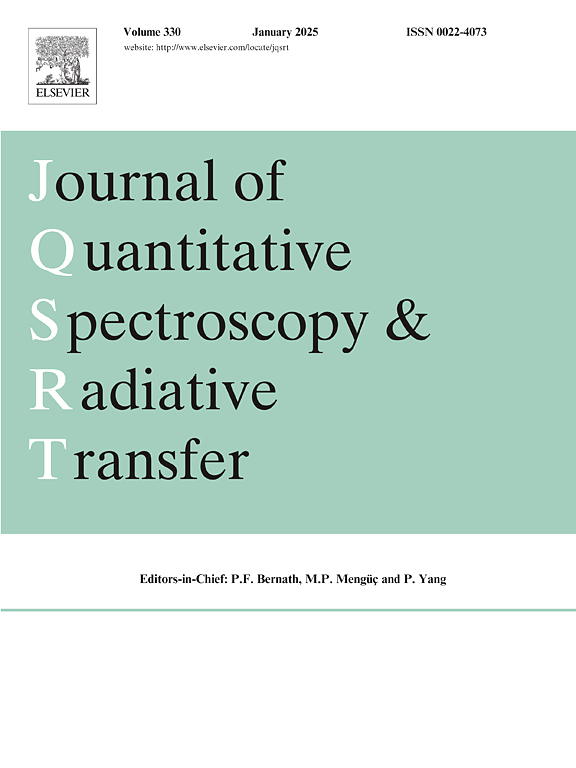Doubly excited (v4=2) vibrational state of 12CH2 35Cl2: Centrifugal distortion and quadrupole splittings in the submillimeter wave spectra up to 1.1 THz
IF 1.9
3区 物理与天体物理
Q2 OPTICS
Journal of Quantitative Spectroscopy & Radiative Transfer
Pub Date : 2025-07-20
DOI:10.1016/j.jqsrt.2025.109585
引用次数: 0
Abstract
The high resolution submillimeter wave spectra of the CH Cl methylene chloride (six spectra were recorded in different parts of the 0.075–1.1 THz spectral region in the I. Physikalisches Institut, Universität zu Köln (Germany) and Laboratoire PhLAM, Université de Lille (France)) were analyzed in the frame of Watson’s Hamiltonian in reduction and representation with the use of the SPFIT/SPCAT package of Pickett. The 2368 unresolved lines (including 878 peripheral lines of triplets) with the maximum values of quantum number and were assigned in the experimental spectra to the vibrational state. Weighted fit of the rotational and centrifugal distortion parameters, as well as, of the nuclear quadrupole splitting parameters was made. The eleven rotational and centrifugal distortion parameters and three nuclear quadrupole coupling parameters obtained from the fit reproduce values of the experimental multiplet centers with the root mean square deviation of 36 kHz and of the experimental peripheral lines of triplets with kHz. Comparison with the rotational and centrifugal distortion parameters of the vibrational state known in the literature is made and shown that they reproduce the same set of the experimental line positions with that is 130 times worse in comparison with the results of the present study. As to the quadrupole coupling parameters, it was found that the three parameters obtained in the fit correlate very well with the corresponding parameters from the recent paper by Z. Kisiel (J Mol Spectrosc 2024;406:111954).
双激发[公式省略][公式省略]CH[公式省略][公式省略]Cl[公式省略]的振动状态:高达1.1 THz的亚毫米波光谱中的离心畸变和四极分裂
使用Pickett的SPFIT/SPCAT封装,在A -还原和Ir -表示的Watson哈密顿框架下分析了12CH235Cl2二氯甲烷的高分辨率亚毫米波光谱(6个光谱分别记录在德国物理研究所Universität zu Köln和法国里尔大学PhLAM实验室的0.075-1.1太赫兹光谱区域的不同部分)。实验光谱中量子数最大值Jmax=83和Kamax=19的2368条未解析谱线(包括878条三重外围谱线)归属于(v4=2)振动态。对核四极分裂参数、旋转畸变参数和离心畸变参数进行了加权拟合。通过拟合再现实验中心均方根偏差为36 kHz和实验外围线drms=47 kHz得到的11个旋转和离心畸变参数和3个核四极耦合参数。与文献中已知的(v4=2)振动状态的旋转和离心畸变参数进行比较,表明它们用drms再现了同一组实验线位置,与本研究的结果相比差了130倍。对于四极耦合的χ -参数,发现拟合得到的三个χ -参数与Z. Kisiel (J Mol Spectrosc 2024;406:111954)最近论文中的相应参数具有很好的相关性。
本文章由计算机程序翻译,如有差异,请以英文原文为准。
求助全文
约1分钟内获得全文
求助全文
来源期刊
CiteScore
5.30
自引率
21.70%
发文量
273
审稿时长
58 days
期刊介绍:
Papers with the following subject areas are suitable for publication in the Journal of Quantitative Spectroscopy and Radiative Transfer:
- Theoretical and experimental aspects of the spectra of atoms, molecules, ions, and plasmas.
- Spectral lineshape studies including models and computational algorithms.
- Atmospheric spectroscopy.
- Theoretical and experimental aspects of light scattering.
- Application of light scattering in particle characterization and remote sensing.
- Application of light scattering in biological sciences and medicine.
- Radiative transfer in absorbing, emitting, and scattering media.
- Radiative transfer in stochastic media.

 求助内容:
求助内容: 应助结果提醒方式:
应助结果提醒方式:


